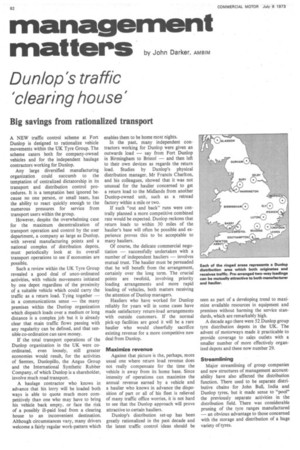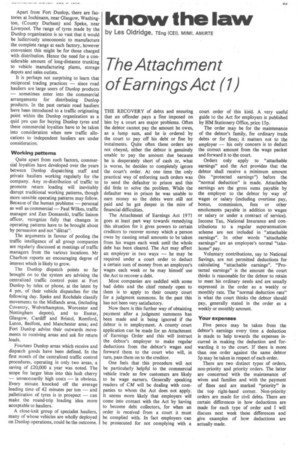management matters
Page 84

Page 85

If you've noticed an error in this article please click here to report it so we can fix it.
Dunlop's traffic,
clearing house'
Big savings from rationalized transport
by John Darker, AMBIM A NEW traffic control scheme at Fort Dunlop is designed to rationalize vehicle movements within the UK Tyre Group. The scheme caters both for company-owned vehicles and for the independent haulage contractors working for Dunlop.
Any large diversified manufacturing organization could succumb to the temptation of centralized dictatorship in its transport and distribution control procedures. It is a temptation best ignored because no one person, or small team, has the ability to react quickly enough to the numerous pressures for service from transport users within the group.
However, despite the overwhelming case for the maximum decentralization of transport operation and control by the user department, a company as large as Dunlop, with several manufacturing points and a national complex of distribution depots, must periodically look at its overall transport operations to see if economies are possible.
Such a review within the UK Tyre Group revealed a good deal of unco-ordinated activities, with vehicle movements initiated by one depot regardless of the proximity of a suitable vehicle which could carry the traffic as a return load. Tying together — in a communications sense — the many premises within the Dunlop organization which dispatch loads over a medium or long distance is a complex job but it is already clear that main traffic flows passing with any regularity can be defined, and that sensible co-ordination can save money.
If the total transport operations of the Dunlop organization in the UK were coordinated, even loosely, still greater economies would result, for the activities of Semtex, Dun'opine, the Angus Group and the International Synthetic Rubber Company, of which Dunlop is a shareholder, involve much road transport.
A haulage contractor who knows in advance that his lorry will be loaded both ways is able to quote much more competitively than one who may have to bring his vehicle back empty, or face the risk of a possibly ill-paid load from a clearing house to an inconvenient destination. Although circumstances vary, many drivers welcome a fairly regular work-pattern which enables them to be home most nights.
In the past, many independent contractors working for Dunlop were given an outwards load — say from Fort Dunlop in Birmingham to Bristol — and then left to their own devices as regards the return load. Studies by Dunlop's physical distribution manager, Mr Francis Charlton, and his colleagues, showed that it was not unusual for the haulier concerned to get a return load to the Midlands from anoiher Dunlop-owned unit, such as a retread factory within a mile or two.
If such "out and back" runs were centrally planned a more competitive combined rate would be expected. Dunlop reckons that return loads to within 30 miles of the haulier's base will often be possible and experience proves this to be acceptable to many hauliers.
Of course, the delicate commercial negotiation — successfully undertaken with a number of independent hauliers — involves mutual trust. The haulier must be persuaded that he will benefit from the arrangement, certainly over the long term. The crucial points are twofold, involving priority loading arrangements and more rapid loading of vehicles, both matters receiving the attention of Dunlop managers.
Hauliers who have worked for Dunlop reliably for years will in some cases have made satisfactory return-load arrangements with outside customers. If the normal pick-up facilities are good it will be a rare haulier who would cheerfully sacrifice existing revenue for a more competitive new deal from Dunlop.
Maximize revenue Against that picture is the, perhaps, more usual one where return load revenue does not really compensate for the time the vehicle is away from its home base. Since intensity of operations can maximize the annual revenue earned by a vehicle and a haulier who knows in advance the disposition of part or all of his fleet is relieved of many traffic office worries, it is not hard to see that the Dunlop approach will prove attractive to certain hauliers.
Dunlop's distribution set-up has been greatly rationalized in the past decade and the latest traffic control ideas should be seen as part of a developing trend to maximize available resources in equipment and premises without harming the service standards, which are remarkably high.
A decade ago there were 52 Dunlop group tyre distribution depots in the UK. The advent of motorways made it practicable to provide coverage to sales outlets with a smaller number of more effectively organized depots and these now number 29.
Streamlining Major streamlining of group companies and new structures of management accountability have also affected the distribution function. There used to be separate distributive chains for John Bull, India and Dunlop tyres, but it made sense to "pool" the previously separate activities in the distribution field. There was considerable pruning of the tyre ranges manufactured — an obvious advantage to those concerned with the storage and distribution of a huge variety of tyres. Apart from Fort Dunlop, there are factories at Inchinann, near Glasgow, Washington, (County Durham) and Speke, near Liverpool. The range of tyres made by the Dunlop organization is so vast that it would be ludicrously uneconomic to manufacture the complete range at each factory, however convenient this might be for those charged with distribution. Hence the need for a considerable amount of long-distance trunldng to vehicle manufacturing plants, storage depots and sales outlets.
It is perhaps not surprising to learn that reciprocal trading practices — since road hauliers are large users of Dunlop products — sometimes enter into the commercial arrangements for distributing Dunlop products. In the past certain road hauliers have been introduced to a traffic originating point within the Dunlop organization as a quid pro quo for buying Dunlop tyres and these commercial loyalties have to be taken into consideration when new traffic allocations to independent hauliers are under consideration.
Working patterns
Quite apart from such factors, commercial loyalties have developed over the years between Dunlop dispatching staff and private hauliers working regularly for the company. Any re-distribution of traffic to promote return loading will inevitably disrupt traditional working patterns, though more sensible operating patterns may follow. Because of the human problems — personal as well as commercial — Paul Wilkes, traffic manager and Zan Domanski, traffic liaison officer, recognize fully that changes in operating patterns have to be brought about by persuasion and not "diktat".
The arguments in favour of pooling the traffic intelligence of all group companies are regularly discussed at meetings of traffic managers from the various locations. Mr Charlton reports an encouraging degree of interest which is likely to grow.
The Dunlop dispatch points so far brought on to the system are advising the centralized traffic control point at Fort Dunlop by telex or phone, at the latest by 4 pm, of their vehicle dispatches for the following day. Speke and Rochdale classify movements to the Midlands area, (including Coventry, Wolverhampton, Worcester and Nottingham depots), and to Exeter, Glasgow, Cardiff and Bristol, Romford, Luton, Bedfont, and Manchester area; and Fort Dunlop advise their outwards movements to receiving areas and ask for return loads.
Fourteen Dunlop areas which receive and dispatch goods have been defined. In the first month of the centralized traffic control procedures, operating in only two areas, a saving of £20,000 a year was noted. The scope for larger bites into this lush cherry — unnecessarily high costs — is obvious. Every minute knocked off the average loading time of 42 minutes per ton — and palletization of tyres is in prospect — can make the round-trip loading idea more acceptable to hauliers.
A close-knit group of specialist hauliers, many of whose vehicles are wholly deployed on Dunlop operations, could be the outcome.




























































































































































